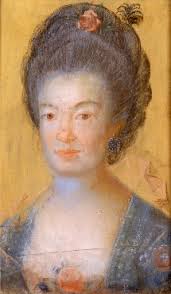Elisabeth Christina von Linné
Elisabeth Christina von Linné (born 1743 ; died 1782 ) was a Swedish botanist .
Live and act
Elisabeth Christina was born in 1743 as the eldest daughter and second child of Carl von Linné and Sara Elisabeth Moræa . She had six siblings. Von Linné received no formal academic training. Presumably she was homeschooled and also followed her brother Carl's studies . At the age of twenty she married Major Carl Fredrik Bergencrantz. The couple had two children, Carl Fredrik and Sara Elisabeth. Carl died early. A few years after the wedding, Elisabeth Christina and her daughter moved back to live with her parents to avoid being mistreated by her husband. She passed away at the age of 39.
In the summer of 1762 von Linné noticed for the first time that the orange-red nasturtium seemed to send out small lightning bolts at dusk. She wrote down her observations and theories about the origin of these lightning bolts and submitted them to the Royal Swedish Academy of Sciences under the title Om indianska krassens blickande (German: About the flickering of the nasturtium ) . Her father added an article of his own to that. The German poet and naturalist Johann Wolfgang von Goethe was fascinated by the phenomenon and called it the "Elisabeth Linnaeus phenomenon". Goethe gave his own observation of this phenomenon in print for the first time in 1810 in the well-known work On Theory of Colors . Over 100 years later, Thore Magnus Fries , professor of botany at Uppsala University, noticed that there were other plants that seemed to be sending out the lightning; all were red-orange. In 1914, Friedrich August Wilhelm Thomas summarized the research and findings on the phenomenon that mainly occurs when the orange-red flowers contrast with the green leaves. He also carries out his own experiments. Heinrich Remberg describes the Elisabeth-Linné phenomenon in 1950 as a special case of the glitter of light points. Accordingly, light stimuli lying above the peg threshold lead to minimal excitation of the pegs. These excitation impulses are superimposed in the visual cortex by spontaneous rhythmic excitation processes and thus cause the appearance.
Linnaeus' discovery also influenced the early English romantic movement . The doctor, scientist and poet Erasmus Darwin mentions this in 1789 in The botanic garden, part II, containing the loves of the plants . Inspired by Darwin's accounts, William Wordsworth and Samuel Taylor Coleridge refer to flashing flowers in their poems.
Individual evidence
- ↑ a b Family life. In: uu.se. Uppsala universitet, accessed March 6, 2018 .
- ^ Louise Petrusson: Carl von Linné forts. In: nrm.se. Naturhistoriska riksmuseet, accessed on March 6, 2018 .
- ↑ a b Mariette Manktelow, Petronella Kettunen: Kvinnorna kring Linné . 2007. p. 44 ff.
- ↑ Elisabeth Christina Linnaea: Om indianska krassens looking walls . In: Kungliga Vetenskapsakademins Handlingar. 1762, p. 284 ff.
- ↑ Carl Linnaea: Om Indianska stark och Dess-looking walls . In: Kungliga Vetenskapsakademins Handlingar. 1762. p. 286 f.
- ^ Friedrich August Wilhelm Thomas: The Elisabeth Linné phenomenon (so-called flashing of the flowers) and its interpretations: For stimulation and clarification, initially for botanists and flower lovers. G. Fischer, Jena 1914
- ^ Heinrich Remberg: About a special case of light point glitter (Lp. Gl.), The Elisabeth Linné phenomenon (ELPh.) . In: Pflügers Archive , Volume 253. 1950. pp. 114–120.
- ↑ Fred Blick: Wordsworth, Coleridge, Science and Flashing Flowers: The Influence of Elizabeth Linnaeus and Erasmus Darwin. 2015
| personal data | |
|---|---|
| SURNAME | Linné, Elisabeth Christina von |
| ALTERNATIVE NAMES | Linnæa, Elisabeth Christina; Linnaeus, Elisabeth; Linnaeus, Elisabeth |
| BRIEF DESCRIPTION | Swedish botanist |
| DATE OF BIRTH | 1743 |
| DATE OF DEATH | 1782 |

